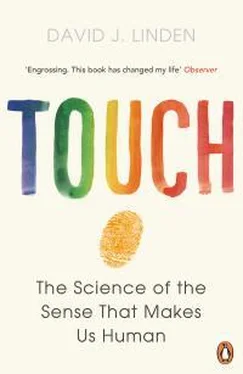2. Aristotle, De Anima [On the Soul] , Book 2.
3. Writing in the year 1900, Cornell University psychologist I. M. Bentley waxed rhapsodic about the skin:
“One of the surprises of physiology is the revelation of the multitude of functions performed by this apparently simple organ. As a rind, it is not only the container but the warder-off, and also the go-between for the organism and its world; tegument, buckler, interagent. It is small wonder that its work is represented in mental process; that many of our most worn and useful perceptions are made up of cutaneous sensations.”
I. M. Bentley, “The synthetic experiment,” American Journal of Psychology 11 (1900): 405–25.
4. My skin would also be found to contain about 5 million hairs and about 2 million sweat glands. Surprisingly, even for women with a full, thick mane, only about 2 percent of those hairs are found on the scalp, as most are fine vellus hairs. At full throttle, when exercising strenuously in hot and humid conditions, our sweat glands can secrete more than a gallon per hour, making us humans the champion schvitzers of the animal kingdom. We may not have the best eyesight or hearing, but we can sweat like crazy. Go Homo sapiens ! And be sure to stay hydrated.
5. Both the Oxford English Dictionary and the Merriam-Webster dictionary say that the correct pronunciation of the word glabrous is GLAY-bruss. However, not a single dermatologist or skin scientist I have met uses this pronunciation. They all say GLAB-russ, except for some of the British scientists who say GLAH-bruss. Given this confusion, I think that you can comfortably use any one of these three pronunciations.
6. Some doctors use a special term for that subset of glabrous skin that borders mucous membranes. In this terminology, mucocutaneous skin includes the lips, conjunctivae (external membranes of the eyes), labia minora, skin surrounding the urethra and anus, etc. While the nipple is entirely glabrous, only the central part of the areola is glabrous, with hairy skin at the periphery. Junot Diaz riffs about this in his splendid award-winning novel The Brief Wondrous Life of Oscar Wao : “Your mother’s breasts are immensities … They’re 35 triple-D’s and the aureoles are as big as saucers and black as pitch and at their edges are fierce hairs that sometimes she plucked and sometimes she didn’t.”
7. For example, the epidermis of the glabrous skin of the fingertips is about ten times thicker than that of the hairy skin of the forearm. The epidermis is thickest on the glabrous skin of the sole, about 1 millimeter, which is about twenty-fold thicker than that of the forearm. This is because the skin of the sole must endure great mechanical stress during walking and running. It’s not surprising that the time it takes for new cells to completely renew the epidermis is longer in those locations where it is very thick. The dermis also varies in thickness over the body surface, ranging from about 1 millimeter in the armpit to about 2.5 millimeters on the back.
8. J. K. McNeely, Holy Wind in Navajo Philosophy (Tucson: University of Arizona Press, 1981), 35.
9. M. J. Henneberg, K. M. Lambert, and C. M. Leigh, “Fingerprint homoplasy: koalas and humans,” NaturalSCIENCE.com 1, article 4 (1997), found at http://naturalscience.com/ns/articles/01-04/ns_hll.html. These authors also mention that fingerprint-like patterns are found on the prehensile tails of some mammalian species. Also see M. Okajima, “Nonprimate mammalian dermatoglyphics as models for genetic and embryological studies: comparative and methodologic aspects,” Birth Defects Original Articles Series 27 (1991): 131–49.
10. T. Lewis and G. W. Pickering, “Circulatory changes in the fingers in some diseases of the nervous system, with special reference to digital atrophy of peripheral nerve lesions,” Clinical Science 2 (1936): 149.
11. Interestingly, glabrous skin that does not have sympathetically controlled sweat glands, like the penile and clitoral glans, does not wrinkle after water immersion.
12. M. Changizi, R. Weber, R. Kotecha, and J. Palazzo, “Are wet-induced wrinkled fingers primate rain treads?” Brain, Behavior and Evolution 77 (2011): 286–90. Their hypothesis is supported by the observation that the particular patterns of ridges and valleys in wet-wrinkled fingers and toes function well for water drainage and mimic the arrangement of natural drainage features found on rain-carved mountainsides, albeit on a much smaller scale.
13. K. Kareklas, D. Nettle, and T. V. Smulders, “Water-induced finger wrinkles improve handling of wet objects,” Biology Letters 9 (2013): 20120999. However, when another group of authors set out to replicate the experiments of Kareklas et al. (2013), they were unable to do so: J. Haseleu, D. Omerbasic, H. Frenzel, M. Gross, and G. R. Lewin, “Water-induced finger wrinkles do not affect touch acuity or dexterity in handling wet objects,” PLOS One 9 (2014): e84949.
14. Electrical spikes (also called action potentials) are the main mode of long-distance information transfer in almost all neurons, not just those that convey information from the skin to the spinal cord and brain. At rest, most neurons have a voltage difference across their outer membranes of about -70 millivolts. When a neuron is depolarized to a level of about -55 millivolts, voltage-sensitive ion channels open, letting sodium ions rush in. Because sodium ions are positively charged, their entry into the neuron depolarizes it further, leading to more sodium-channel opening, in a positive feedback loop, causing the rapid upstroke of the spike. About a millisecond later, voltage-sensitive potassium channels open and the sodium channels close, causing potassium to rush out, thereby underlying the downstroke of the spike. Importantly, spikes can propagate from one patch of membrane to another, like a flame traveling along a fuse, igniting the next section as it moves along. This is how spikes travel along nerve fibers from the skin to the spinal cord, and ultimately up to the brain. If you’d like a somewhat more complete explanation of spike signaling in neurons, together with some diagrams, see this section of my earlier book: D. J. Linden, The Accidental Mind (Harvard/Belknap Press, 2007), 28–49.
15. It should be noted that there are several different families of stretch-activated ion channels and that they are present in many cell types ranging from white blood cells to kidneys. In the nervous system, stretch-activated channels are also important in the hair cells of the inner ear, where they help to convert the mechanical energy of sound waves into electrical signals that travel to the brain. The molecular identity of the stretch-activated ion channels that underlie touch perception is not completely understood. At present, the best candidates are proteins called Piezo1 and Piezo2. B. Coste, B. Xiao, J. S. Santos, R. Syeda, J. Grandl, K. S. Spencer, S. E. Kim, M. Schmidt, J. Mathur, A. E. Dubin, M. Montal, and A. Patapoutian, “Piezo proteins are pore-forming subunits of mechanically activated channels,” Nature 483 (2012): 176–81. Good summaries of the current state of the struggle are found here: D. M. Bautista and E. A. Lumpkin, “Probing mammalian touch transduction,” Journal of General Physiology 138 (2011): 291–301; and B. Nilius and E. Honoré, “Sensing pressure with ion channels,” Trends in Neuroscience 35 (2012): 477–86.
16. The original description by Merkel is F. S. Merkel, “Tastzellen und Tastkörperchen bei den Hausthieren und beim Menschen,” Archiv für mikroskopische Anatomie 11 (1875): 636–52. The title translates as “Touch cells and corpuscles in domestic animals and humans.” While Merkel named his newly discovered cells tastzellen , arguments about whether they really function as touch sensors went on for years; 134 years, to be exact. In 2009, Huda Zogbhi and collaborators finally put this issue to rest by using genetic engineering to create mice that lacked Merkel cells. Recordings from nerve fibers in these mice showed a lack of characteristic sustained light-touch responses. Sometimes science requires a lot of patience. S. M. Maricich, S. A. Wellnitz, A. M. Nelson, D. R. Lesniak, G. J. Gerling, E. A. Lumpkin, and H. Y. Zogbhi, “Merkel cells are essential for light-touch responses,” Science 324 (2009): 1580–82. If we’re to dig a bit deeper, there are still fundamental questions that remain. Where is the precise location where the force of skin indentation is transduced into an electrical signal? Is it in the Merkel cells, in the Merkel cell-contacting nerve fibers, or both? When Merkel cells are genetically deleted, this abolishes electrical responses in the touch-sensing nerve fiber. Yet there are several possible explanations for this result:
Читать дальше












